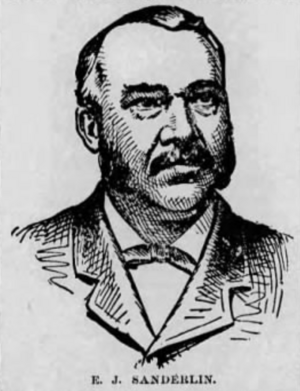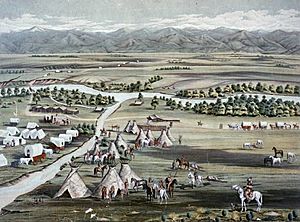Edward J. Sanderlin facts for kids
Quick facts for kids
Edward J. Sanderlin
|
|
|---|---|
 |
|
| Born | September 14, 1865 New Orleans, Louisiana
|
| Died | April 15, 1909 (aged 43) Denver, Colorado
|
| Nationality | American |
| Occupation | Entrepreneur, investor |
| Years active | 1852–1890 |
Edward J. Sanderlin (born September 14, 1835 – died April 15, 1909) was an important American businessman and civil rights leader. He was born into slavery but later became a very successful entrepreneur and investor.
Sanderlin moved to Cincinnati, Ohio, around 1850. There, he attended the Gilmore School. He later joined the exciting California Gold Rush and the Pike's Peak Gold Rush in Colorado.
In the early days of Denver, Colorado, he owned a barbershop and a restaurant. He became very rich by investing in mines in Colorado and California.
Edward Sanderlin also worked hard for equal rights. He fought for African American men to have the right to vote. He also helped make sure black children could get an education. In 1973, he was honored by being added to the Blacks in Colorado Hall of Fame.
Contents
Edward Sanderlin's Early Life
Edward J. Sanderlin was born on September 14, 1835, in New Orleans, Louisiana. His mother was an enslaved woman. His father, Wilson Sanderlin, was British and owned large farms in Tennessee.
When his father died, Edward's mother fought for her children's rights. Because of her efforts, Edward and his siblings each received a large sum of money.
Sanderlin went to the Gilmore High School in Cincinnati. This school was special because it offered high school education to African American students. It helped many black and biracial children get an education during a time when it was hard for them.
His Career and the Gold Rushes
In 1849, Sanderlin traveled west from Tennessee. He joined the California Gold Rush (1848–1855), which was a time when many people rushed to California to find gold. He became wealthy from this adventure. However, he later lost his money by making risky investments in the eastern United States.
By 1850, he was a 19-year-old barber living in Cincinnati. He then moved to Colorado for the Pike's Peak Gold Rush (1858–1861). He arrived in Denver on June 11, 1859. At that time, Denver was a new town in the Kansas Territory. It was a busy place that helped gold miners by offering restaurants, shops, and entertainment.
In Denver, Edward Sanderlin opened a restaurant and a barbershop. He was known for serving excellent food, even bringing in oysters from the Missouri River. He also bought high-quality dairy products from local farms. He invested his money wisely in real estate and ranches. His investments in mines made him very rich.
By the time he retired in 1890, he was worth a lot of money. However, he lost most of his wealth during the Panic of 1893, which was a big economic crisis.
Fighting for Civil Rights
In 1861, the government in the Colorado Territory passed a law. This law made African American property owners pay taxes for public schools. But their children were not allowed to attend these schools.
Edward Sanderlin, along with Lewis Henry Douglass and William Jefferson Hardin, fought against this unfair rule. They worked to get equal education for black children. At first, white and black children were taught in the same school building but on different floors. Later, black children were taught in rented buildings and churches. Finally, in 1873, Denver's schools became integrated, meaning all children could attend together. Sanderlin also wanted black people to learn skilled jobs.
In 1864, Colorado was allowed to apply to become a state. But the next year, African Americans lost their right to vote.
Sanderlin, William Jefferson Hardin, Henry O. Wagoner, and Barney Ford worked hard to change this. They asked Congress, the local government, and people living in Colorado to only allow statehood if all men could vote. Hardin gathered signatures for a petition asking for voting rights. This petition was sent to the United States Congress. Even Frederick Douglass, a famous abolitionist, and his sons helped with this important campaign.
After many years, Colorado became a state on August 1, 1876. The new state constitution did not stop men from voting based on their race. This was a big victory for civil rights.
His Personal Life
Edward Sanderlin married Georgiana Epps on January 13, 1858, in Hamilton, Ohio. They had seven children together: William, Isabel, Cora, Harry, Clara, Maude, and Georgiana. His wife, Georgiana, was one of the people who helped start the Zion Baptist Church.
Sanderlin was good friends with Barney Ford, another successful African American businessman. He was part of a group of four men who were born into slavery but became very successful. These men, including H. O. Wagoner, W. J. Hardin, and W. H. Green, helped each other succeed. They also helped other African Americans settle in Colorado and buy homes.
Edward Sanderlin retired in 1890. His wife, Georgiana, passed away in August 1908. Edward died from pneumonia at his home on April 15, 1909. He had lost most of his money during the Panic of 1873, another economic downturn. At the end of his life, he was not as rich as he once was. He was buried at Riverside Cemetery in Denver, Colorado.
See also


